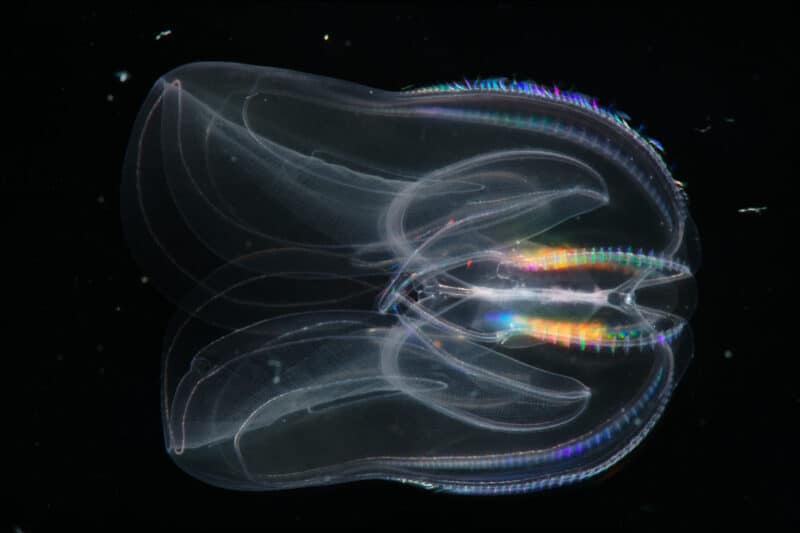The Sea Walnut: Unwanted but not Unloved
This comb jelly is more than a gelatinous blob – it’s a notorious ecosystem invader, a highly adaptable survivor, and a master of reproduction. The sea walnut’s bizarre nature fuels both dreams and nightmares, but for this marine biologist, it was love at first sight.
This essay was first published in German in the book “Fluide Mediale” under the title “Wie aus einer ‘amerikanischen Schönheit’ ein Albtraum wurde.”
I am often asked, “What fascinates you about working with jellyfish?” My response is usually that jellyfish are among the oldest animals in the world, even older than dinosaurs, yet they are still around to be studied. I find it truly fascinating how jellyfish survived several mass extinctions despite their relatively primitive biology. They can be considered masters of evolution and adaptation, which is what keeps me motivated to work with them.
Originally, my interest in jellyfish began when I was a Master of Science student in Marine Fish Biology at an Iranian marine station in the southern Caspian Sea. In the 1990s, higher education for female students and scientists in Iran did not match Western standards. When it came to field-going studies, especially in marine science, where one had to be able to board a research ship, we were far behind the rest of the world. Female students were not allowed to participate in any research cruises, which meant that most of us had to limit our work and interests to laboratory work experiments.
Some lucky students had connections to a research institution and could (at least) ask for samples from the field to be delivered by a male colleague, but they were not allowed to collect samples themselves. I was no exception. For my master thesis, I chose to study fish taxonomy and identify fish specimen at the National History Museum in Tehran, using materials gathered from the Persian Gulf before the revolution. Of course, I was working at a lab desk.
How an “American Beauty” became a Nightmare
The Caspian Sea is one of the world’s oldest and largest enclosed water bodies, with brackish water in the south and nearly fresh water in the north. The sea is a strategic region due to its large volume of natural gas and oil, but is also recognized as a treasure trove of biodiversity, being home to a vast array of endemic species that have evolved in that specific environment for millions of years. Moreover, some Caspian species are of great commercial value, e.g. sturgeon fish that produce caviar.
Unfortunately, the Caspian Sea has been heavily impacted by anthropogenic stress linked to intensive oil and gas exploitation, overfishing, agricultural activities, species invasion, tourism, and habitat modification. This cumulative impact has triggered conspicuous ecosystem-wide degradation. At the same time, the entire Caspian environment faced a new invasive species known as the American sea walnut, a type of comb jelly. The sea walnut has become a symptom, a visible indication of the ecosystem’s poor health.
“The sea walnut has become a symptom, a visible indication of the ecosystem’s poor health.”
The sea walnut first arrived in the Black Sea in the late 1980s, likely transported by cargo ships’ ballast water from the American coasts of the Atlantic. It then spread quite rapidly around the globe and appeared in the Caspian and all European seas within a decade, sometimes with a considerable negative impact on entire ecosystems. Even so, it is worth asking ourselves the question: Should we always blame the most obvious thing for our own mistakes? In the early years after its appearance, the comb jelly was blamed for the ecosystem collapse of anchovy fishery in the Black Sea. However, it took scientists several years to show this was caused by multiple human-made factors such as overfishing, ecosystem mismanagement, and ongoing climate change, which provided a new niche for the sea walnut to establish itself.
Due to its quick range expansion, the American comb jelly was counted as one of the world’s 100 worst invasive alien species in 2000, designating the species an unwelcomed guest. At the beginning of the twenty-first century, the sea walnut was increasingly spotted around the Caspian Sea, where I was conducting my studies. I vividly remember watching a TV report about the new invasive American comb jelly. In the report, a fisherman reached into a bucket, pulled out a handful of jelly-like and slimy materials, and exclaimed that these creatures ate the larvae of small fish. I fell in love with this creature called Mnemiopsis leidyi at first glance.

A Lady Named Mnemiopsis leidyi
The sea walnut, Mnemiopsis leidyi, belongs to the animal group known as “Ctenophores,” commonly referred to as comb jellies in English. They differ from true jellyfish by having eight rows of small eyelash-like plates called cilia, which they use to move around. Jellyfish specialist Dr. Claudia Mills from the University of Washington explains best why this group is called ctenophores:
“In American English, the name is pronounced with a silent ‘c,’ as ‘teen-o-four’ or ‘ten-o-four.’ The preliminary ‘c’ is pronounced in most European languages (as a syllable ‘ka’). Ctenophores are characterized by eight rows of cilia, which are used for locomotion. The cilia in each row are arranged to form a stack of combs, also called comb plates or ctenes; thus, the name ctenophore comes from the Greek, meaning ‘comb bearer’ [The more complete derivation, provided by H. Foundalis and T. Christopoulos, is that ‘ctena’ means comb in ancient Greek (in Modern Greek, too: ‘ktena’) and ‘phora’ is a morphological ending that comes from the Greek verb ‘pherein,’ to bear (Modern Greek: ‘phero”).]”
The group consists of over 200 different species, possibly only half of the known ctenophores in the sea, according to Claudia Mills. Some appear only in the deep sea, some inhabit the seafloor, and many others, like the sea walnut, can be found in coastal areas. Mnemiopsis leidyi is a famous member of the ctenophores, and for good reason. Unlike other ctenophores, they demonstrate a considerable ability to adapt themselves. In their native range, you can find sea walnuts from the coast of Argentina in the south Atlantic to New England in the North. They can tolerate both warm and cold-water conditions and even cope with low oxygen or low pH levels for a while. They are “unfussy,” feeding on various items from microscopic and tiny plankton to prey organisms ten times bigger than their own body. Also, they do not care much about the salinity of the water.
“When it comes to breeding, sea walnuts are masters.”
When it comes to breeding, sea walnuts are masters. One individual can produce hundreds and under optimal conditions thousands of larvae per day! Many animals need both a female and a male individual to reproduce new offspring. Comb jellies, however, are bisexual (hermaphrodite), meaning that one animal can produce both sperm and eggs. What’s more, unlike many other animals, sea walnut larvae can become sexually active and produce other larvae. What a weird comb jelly world! These creatures seem even more bizarre considering how fast they can heal themselves. If you cut a larva in half, it can close the wound within seconds and then regenerate the other half in just ten days.
All these factors contributed to the sea walnut’s rapid expansion upon arriving in exotic habitats like the Caspian Sea or the Baltic Sea.
“Scheisse!”
My passion for working on the sea walnut became a reality when I was awarded a scholarship to study abroad in Germany. In my letter to Professor Ulrich Sommer, at the Leibniz Institute for Marine Science, I expressed my interest in working on the jellyfish of the Baltic Sea, especially on ctenophores. Ironically, he wrote back, “Only if you promise not to bring any of those invasive comb jellies with you.”
Upon arriving in Kiel, a city north of Hamburg, I immediately established a weekly sampling in the Kiel Fjord, knowing how important it was to monitor jellyfish. Two years later, in October 2006, I took my net out as usual and discovered something unexpected: several specimens of a comb jelly, resembling the sea walnut! I thought they might be some species from the Kattegat or Skagerrak area that were only new to me. But damn it, they very much looked like Mnemiopsis leidyi. I picked up my identification key, not confident enough to rely on my previous knowledge about sea walnuts, and checked all available sources to be sure. And indeed, I held Mnemiopsis leidyi in my hands. I ran to Professor Sommer’s office and with a shaky voice I told him, “Uli, I found Mnemiopsis leidyi! And not only one but several.” He turned back from his computer, looked at me for some seconds, and finally said, “Scheisse” (shit!).
“We can already see how fast Mnemiopsis leidyi is adapting to early summer and late springtime.”
This new finding initially shocked Baltic coastal managers, fishery associations, and marine scientists, but only for a relatively short time. Ever since, we have been interviewed on almost all media channels, and the species has been spotted in all European water bodies: the North Sea, Wadden Sea, and northern Mediterranean coastal areas. However, contrary to our expectations, the sea walnut did not have a considerable effect on the fish population of the fragile Baltic Sea because its appearance was limited to late summertime and was largely kept under control by the low salinity of the area. The lack of overlap between fish juveniles and sea walnuts was good news. Still, hope may dwindle because of climate change, which is shifting species distribution, and we can already see how fast Mnemiopsis leidyi is adapting to early summer and late springtime.
Recently, we have been exploring the possibility of producing goods from the abundant biomass of the invasive comb jelly. The idea is to harvest them and turn them into fertilizers suitable for small-scale gardening. Currently, the project is waiting to be funded, so keep your fingers crossed! While we cannot avoid the beautiful “American beauty” by the name of sea walnut, we might at least be able to make use of it.
Check out this related title from De Gruyter
[Title image by MWCPhoto/iStock/Getty Images Plus]
